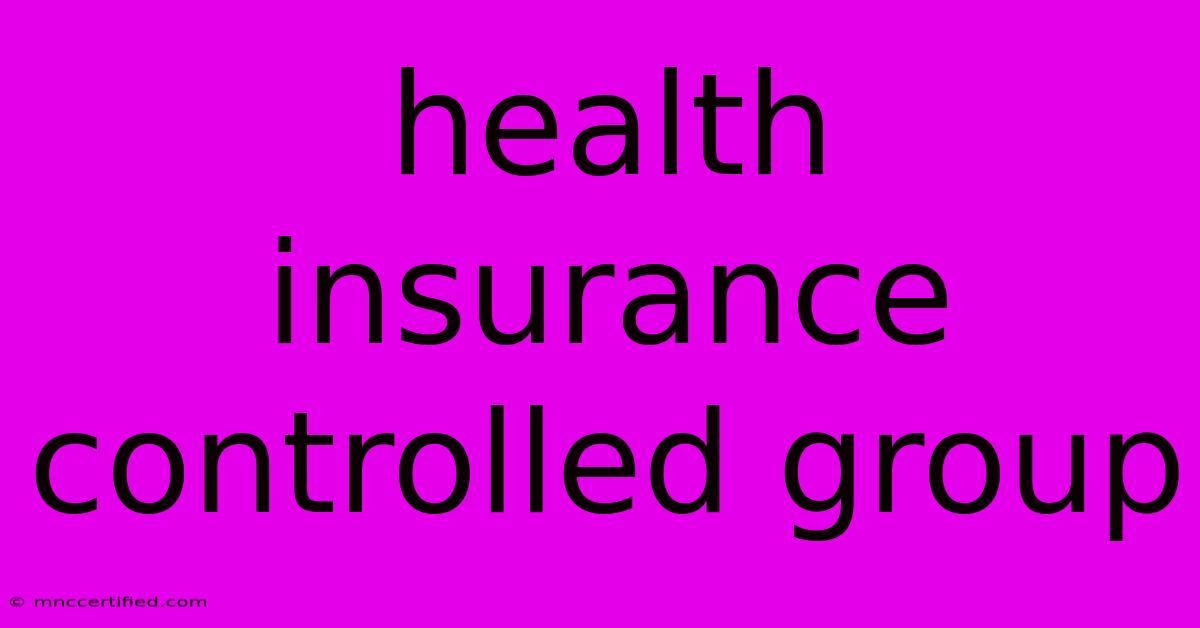Health Insurance Controlled Group

Table of Contents
Understanding Health Insurance Controlled Groups: A Comprehensive Guide
Navigating the complexities of health insurance can be challenging, especially for larger organizations. One key concept that significantly impacts insurance premiums and compliance is the health insurance controlled group (HICG). This article provides a comprehensive overview of HICGs, explaining what they are, how they're determined, and their implications for businesses.
What is a Health Insurance Controlled Group?
A health insurance controlled group is a group of corporations, partnerships, and other entities considered a single employer for the purposes of determining eligibility for small business health insurance tax credits and for complying with the Affordable Care Act (ACA) employer mandate. Essentially, the IRS treats these related entities as a single, large employer, regardless of their separate legal structures. This aggregation affects the calculation of employee headcount, which in turn influences the employer's responsibilities under the ACA.
This means that even if multiple entities operate independently, if they meet certain criteria, they are treated as one large employer for health insurance purposes. This can significantly impact their insurance costs and compliance obligations.
Why is understanding HICGs crucial?
Understanding HICG status is crucial for several reasons:
-
Affordable Care Act (ACA) Employer Mandate: If a HICG has a sufficient number of full-time equivalent (FTE) employees, it may be subject to the ACA's employer mandate, requiring the offering of affordable health insurance coverage or facing penalties. The total FTE count across all entities within the HICG is considered.
-
Premium Costs: The premium rates for health insurance are often based on the total number of employees. Being part of a HICG can significantly impact the overall premium, potentially leading to higher costs compared to smaller, independent entities.
-
Compliance: Accurate identification of HICG status is essential for ensuring compliance with various federal regulations concerning health insurance. Failure to correctly determine and report HICG status can result in significant penalties.
Determining Health Insurance Controlled Group Status
The IRS uses specific rules to determine whether a group of entities constitutes a HICG. These rules are complex and depend on the relationships between the entities involved. The most common tests used are:
1. The Parent-Subsidiary Test:
This test applies when one entity (the parent) directly or indirectly owns 80% or more of the voting power or stock value of another entity (the subsidiary). If this relationship exists among multiple entities, they may form a HICG.
2. The Brother-Sister Test:
This test focuses on common ownership. If five or more entities are each owned by the same five or fewer individuals or entities (5/50 rule), they may be considered a HICG. The percentage of ownership within each entity isn't as critical as the overlapping ownership across multiple entities.
3. The Combined Test:
This test is a combination of the parent-subsidiary and brother-sister tests. It involves identifying whether a chain of relationships, combining aspects of both tests, results in a group of entities that are treated as a single employer for health insurance purposes.
Implications of Being a Health Insurance Controlled Group
Being identified as a HICG has several significant implications:
-
Increased Employer Responsibilities: The ACA employer mandate, with its reporting requirements and potential penalties for non-compliance, applies to the entire HICG based on the aggregated FTE count.
-
Higher Insurance Premiums: Larger employee counts usually translate to higher premiums. The aggregated employee count of the HICG can lead to substantially higher insurance costs compared to separate entities.
-
Complex Compliance: Accurate tracking and reporting of employee information across multiple entities is critical for compliance, adding complexity to administrative tasks.
-
Strategic Planning: Businesses need to carefully consider the potential implications of HICG status when making strategic decisions like mergers, acquisitions, or restructuring.
Seeking Professional Guidance
Determining HICG status can be a complicated process. It's highly recommended to consult with experienced tax professionals or insurance brokers who specialize in health insurance compliance. They can help you accurately assess your status, understand your responsibilities, and develop strategies to minimize costs and ensure full compliance with all relevant regulations. Don't hesitate to seek professional help – it's a worthwhile investment to avoid potentially significant financial penalties and compliance issues.
This comprehensive guide offers a foundation for understanding health insurance controlled groups. Remember, the information provided here is for educational purposes only and does not constitute legal or tax advice. Always consult with qualified professionals for personalized guidance.

Thank you for visiting our website wich cover about Health Insurance Controlled Group. We hope the information provided has been useful to you. Feel free to contact us if you have any questions or need further assistance. See you next time and dont miss to bookmark.
Featured Posts
-
Ionic Bonding Chemistry Worksheet
Nov 18, 2024
-
Aston Martin Model Car James Bond
Nov 18, 2024
-
Heat N Bond Lite Iron On Adhesive
Nov 18, 2024
-
49ers Kittle Injury Report Today
Nov 18, 2024
-
Confident Katy Perry A Bang Showbiz Report
Nov 18, 2024